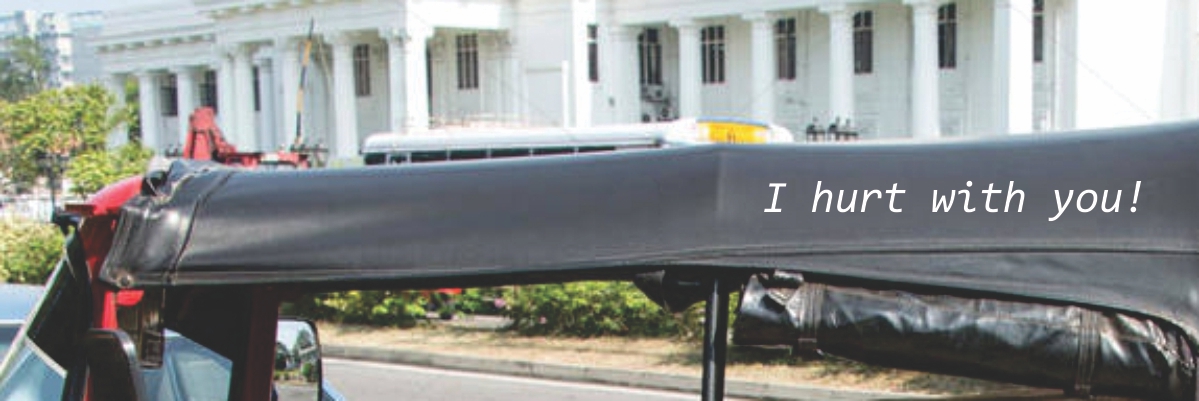
I hurt with you! March 22, 2019
 |
||
|
Seen recently on a three-wheeler
|
||
To tell the truth, the US has spent nearly $6 trillion on wars that have resulted in the deaths of at least 500,000 people since 9/11. Guns kill people (more often in the US than any other non-war zone). Vaccines do not cause autism. Speaking up against Israel's war crimes against Palestinians is not anti-Semitism.
To tell the truth, the so-called president of the US is a racist, a white supremacist, a conman, and a cheat. To tell the truth, the US government is being run as a criminal- mob enterprise. To tell the truth, the risk of nuclear war is closer now than ever before. To tell the truth, fascism is rising, and we're taking way too long to restore sanity and honesty. To tell the truth, we may not get out of this mess as a species and we may just take all life on the planet out with us.
To tell the truth, we've had a number of false starts in writing this report. We got bogged down in discussing whether Trump's falsehoods are lies, ignorance, gaslighting, or bullshit. We asked ourselves whether Trump is a trickster, a garden-variety liar, a pathological liar, a poorly educated and filthy rich, white spoiled brat, or just plain stupid and completely ignorant of the simplest facts. Finally, we realized that that is an irrelevant question and a waste of time to consider.
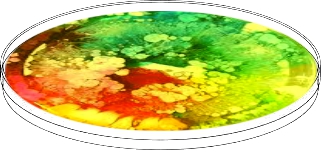 If you find an old petri dish, carelessly abandoned on a shelf in a lab, teeming with dangerous germs and microbes, you won't take time to examine, classify and analyze every nasty thing growing there. You will immediately destroy all the potentially lethal organisms, clean the dish, sterilize it, and put it away.
If you find an old petri dish, carelessly abandoned on a shelf in a lab, teeming with dangerous germs and microbes, you won't take time to examine, classify and analyze every nasty thing growing there. You will immediately destroy all the potentially lethal organisms, clean the dish, sterilize it, and put it away.
In the same way, it is difficult to sort through the fake news, alternate facts, lies, propaganda, and ignorance that abound in today's news. Perhaps the best way to regard it is as the "weaponization of ignorance." Ignorance creates an atmosphere in which lies are unquestioningly offered and accepted. Ignorance is blamable, willful ignorance is deplorable.
| Malicious ignorance is a willful refusal to reflect enough to do justice to the complexity of an idea and its potential consequences. This is a kind of ignorance that combines the mindset of tyrants with a notion of unreflective certainty that banishes doubt and views opposing positions as acts of treason that are often deserving of some kind of punitive action. Unfortunately, we live at a moment in which ignorance appears to be one of the defining features of U.S. political and cultural life. Ignorance has become a form of weaponized refusal to acknowledge how the violence of the past seeps into the present, reinforced by a corporate-controlled media and digital culture dominated by fatuous spectacles and consumerist trivia. --"Resisting the Weaponization of Ignorance in the Age of Trump," By Henry A. Giroux, Truthout |
|||
It would be exhausting to list all the threats to life on this planet, but to name only a few: nuclear war, a nuclear accident, conventional war, new or resurgent diseases, famine, and climate catastrophe. WHO has just put out its 2019 list of the ten they consider most serious.
Nevertheless, everyday we hear voices denying or downplaying all of them.
Concerning what WHO euphemistically calls "Vaccine Hesitancy" consider the remarkable case of the 6-year-old boy in Oregon who developed tetanus because he had never been vaccinated. How fortunate he was that his life-threatening condition was diagnosed at all, since no one who examined him had ever seen an actual case of tetanus! Even after intensive care, indescribable pain, a hospital stay of 57 days, and a bill of $800,000 bill, his parents still refused to allow him the requisite second round of vaccinations. We can only ask, "What were they thinking?"
Back when the world was new, according to a rather engaging Jataka, people didn't lie. They didn't even know what a lie was. When the king declared that, by telling a lie, he would make the junior the senior, in order to have his childhood friend appointed his chief advisor, no one understood what he meant.
 |
|
|
Click the image to read
"The First Lie" |
|
|
"What is a lie?" People wondered, "Is it yellow?" "Is it blue?" "How big is it?" "Will we be able to see it?" "Will it have a smell?" On the day which the king had specified, hoping to see a lie and to discover what it was, a huge crowd gathered in the palace courtyard |
|||
His wise advisor warned him that a lie was a grievously dangerous thing and that, by lying, he would destroy himself. Undeterred, the king stubbornly persisted, repeating his lie again and again, and, finally, he fell into hell.
All religions abhor lying. In Buddhism, the liar is said to be capable of any and all evil actions. We must admit that, because of vicious racism, unrestrained greed, blatant dishonesty, and deep-seated ignorance, Trump's government is guilty of uncountable evil actions, resulting in an increase of suffering, global uncertainty, and national decline at an incredible rate.
Perhaps we have passed the tipping point, and we are facing the end of civilization. Death of each individual, of course, is certain. Death is signless, since we don't know when, where, or how it will come about, but come it will, inevitably. That does not mean, however, that we should give up, either personally or for the good of society. Striving, resisting, speaking out, showing kindness, empathy, and compassion, and declaring the truth have an intrinsic value.
Recently a friend wrote, quite seriously, about a decision he'd made.
|
I have my trepidation regarding this path, too; but, again, that's neither here nor there. (And, frankly, how would my harboring reservations make this path different from any other path I could have chosen?) I'd like to say, "We'll be alright." But that'd ring rather hollow, wouldn't it? We won't be "alright." Having been born, we'll toil, suffer, and die (perhaps, without even the chance to get old). The ONLY refuge is the Dhamma. So--today being a full moon day -- this evening, we will reflect on paticca-samuppada, metta, asubha, and death. Don't worry. Everything is broken. |
|||
The notion that every decision is equal because we're all going to die anyway, or that this world is doomed, doesn't seem like Dhamma to us. Although "fatalism" is most often used to refer to an attitude of resignation in the face of some future event which is thought to be inevitable, philosophers usually use the word to refer to the view that we are powerless to do anything other than what we actually do. Our friend seemed to be saying that no matter what path he chose, the result would be exactly the same. Of course, success can never be guaranteed, but making any decision is an intentional action, which is "kamma." The wiser the decision, the better. Buddhism has no place for a fatalistic attitude, which applies to personal choices as well as concerted, cooperative efforts to reverse something as huge as climate catastrophe! Not speaking up in the face of injustice, not acting to counter wrong, are choices too. Indifference or doing nothing is not a moral option.
We need to make good choices, using right view, right thought, right speech, right action, right livelihood, right effort, right mindfulness, and right concentration. Opting out is not an option, but we need to be skillful, making wise and informed decisions, based on truth, morality, loving-kindness, compassion, sympathetic joy, and equanimity, to exercise our rights as citizens with power and influence in a democracy, not unlike the duties of a king in olden times.
|
The insight and equanimity cultivated by eco-bodhisattvas support what is most distinctive about Buddhist activism: acting without attachment to the results of action, something that is easily misunderstood to imply a casual attitude. Instead, our task is to do the very best we can, not knowing what the consequences will be—in fact, not knowing if our efforts will make any difference whatsoever. We don't know if what we do is important, but we do know that it's important for us to do it. Have we already passed ecological tipping points and civilization as we know it is doomed? We don't know, and that's okay. Of course we hope our efforts will bear fruit, but ultimately they are our openhearted gift to the earth. --David Loy, "Can Buddhism Meet the Climate Crisis?" |
|||
Recently we read" Maha-Janaka Jataka" with our students. That story, with its emphasis on determination, making effort, and striving, has particular relevance to our situation in today's world, threatened as we are, with extinction, just as the young prince was faced with death at sea.
 |
|
|
Click the image to read
"Maha-Janaka" |
|
|
When he [Maha-Janaka, son of a deposed king, raised secretly in exile] reached sixteen, he asked his mother if she had any money for him. "If you don't," he said, "I will go into trade to make money, and I will regain my father's kingdom." "Dear son, I did not come here empty-handed,"she told him. "I have a great store of pearls, rubies, and diamonds. Take it all. It is enough to win the throne. You don't need to go into trade." "No, Mother," he replied, "I will only take half of what you have. I will use that to travel to Suvannabhumi. I'll make my fortune and return to seize the kingdom." His mother begged him not to do such a foolish thing. She warned him that there were great dangers at sea and that his chances of making a profit were very slim. Despite her pleas, he was determined to try his luck. He joined with six other traders and invested half of her wealth. The group loaded a ship with expensive goods, wagons, and oxen and left for Suvannabhumi. The vessel sailed for seven hundred yojanas, but, after a week, it hit rough water and sprang a leak. Planks gave way, the water rose, and the ship began to sink. The crew and the merchants cried and invoked their various deities, but Maha-Janaka neither wept nor prayed. Knowing that the ship was doomed, he smeared his body and clothing with ghee, ate as many rations as he could manage, and climbed to the top of the main mast. As the ship sank beneath the surface, the mast remained upright, but the men and animals on the deck became food for the sharks and turtles. The water around the submerged vessel turned blood red as it was churned up by their frenzy. From the top of the mast, Prince Maha-Janaka threw himself with all his strength in the direction of Mithila . He landed in the emerald sea, safely beyond the ravenous predators. On the day that Prince Maha-Janaka had embarked for Suvannabhumi, King Pola-Janaka had fallen seriously ill and was unable to leave his bed. As the ship sank, the king died. For seven days, Maha-Janaka swam steadily without changing his pace. When he saw the full moon rise, he rinsed his mouth with salt water and began observing Uposatha. In that sea, a female deva named Manimekhala had been appointed guardian by the Four Great Kings. In charging her with her duty, they had told her, "Beings who are virtuous, who respect their parents, and who observe Uposatha do not deserve to perish in the sea. If any virtuous people become shipwrecked, you must save them." For the seven days that Maha-Janaka had been swimming, Manimekhala had been absorbed in her divine happiness and had neglected to look about. At last, recollecting her responsibility, she surveyed the water and saw Maha-Janaka struggling. When she noticed that he was observing Uposatha, she thought, "If Prince Maha-Janaka had perished because I was remiss, I would have lost my place in the divine assembly! Now I must save him, but, first, let me test him!" Assuming a beautiful form, she stood in the air not far from where he was swimming and asked, "Young man, why are you striving manfully in mid-ocean? Are you all alone? Where are your friends?" Maha-Janaka thought, "I have been swimming for seven days. All this time, I have not seen another living being. This must be a deva who is speaking to me now!" Aloud he said, "As long as I am alive, I see it as my duty to strive with all my strength." "Well, it seems obvious to me that here in the deep sea your striving is useless," Manimekhala replied. "There's nothing you can do, and you are going to drown!" "Why do you say that?" Maha-Janaka retorted. "If I struggle as hard as I can, I cannot be blamed even if I die. He who does as much as he can should not feel ashamed if he fails." "Why exhaust yourself for nothing?" the deva taunted him. "Since you are going to die anyway, you might as well relax!" "The man who thinks that there is no chance to win and, thus, gives up without a fight is the one who should be blamed when he loses!" Maha-Janaka declared. "Only the future will show whether our plans will succeed or fail. Don't you see, friend deva? My struggling has kept me alive this far, whereas all my companions on the same ship drowned. The ship sank, but I saved myself. Now here I am, and you are standing by my side. As long as I am alive, I will struggle as hard as I can to get through these ocean waves and to reach the shore. As long as my strength holds out, I will strive until I can strive no more." "You are truly brave," Manimekhala shouted, "to continue fighting on in this fierce, unbounded sea, struggling to do your duty like a man, never wavering, never shrinking from your task! Tell me where you wish to go. There will be no more obstacles to hamper you!" "My destination is Mithila!" Maha-Janaka loudly proclaimed. Manimekhala lifted him gently from the water as if he were her own child and sped toward Mithila." |
|||
If we refuse to give up hope, make wise and informed choices, and exert our best efforts to undo the harm done by the greed, hatred, and ignorance perpetrated by the selfish, rich, and powerful around us, maybe we, too, will have the gods on our side!
Hurray for all the young people (and their teachers) going out on strike to "save our Mother earth!" Heartening indeed to see their demonstrations against the selfish and powerful whose greed and ignorance threaten us all.
Speaking of saving the environment and forestalling climate catastrophe, one major concern is renewable energy. Everyone is pointing out that for far too long, the world has been blindly dependent on dirty, nonrenewable fossil fuels, while blithely ignoring the clean energy available from the sun, wind, and water.
 You may remember that, almost as soon as we moved into our current residence, we installed a solar water-heating system for 150,000 rupees ($1350), which we were able to pay with our credit card.. The system has worked beautifully with absolutely no maintenance. Since then, we have occasionally inquired about going solar for our electricity, but estimates have been more than our budget could handle.
You may remember that, almost as soon as we moved into our current residence, we installed a solar water-heating system for 150,000 rupees ($1350), which we were able to pay with our credit card.. The system has worked beautifully with absolutely no maintenance. Since then, we have occasionally inquired about going solar for our electricity, but estimates have been more than our budget could handle.
About two weeks ago, we received a call from the CEO of a solar energy company, saying that he had been given our number by a bank manager. We remembered that, some time back, when that manager had visited our house to discuss a time deposit, we had casually mentioned our interest in micro-credit in Sri Lanka and solar energy, which, we pointed out, is officially discouraged in Thailand. After the CEO had described his company's system, we replied that it was rather too expensive for us to consider (even though it was less than we had been quoted from other companies). He explained that the government was offering loans at 8% interest to any who installed a solar system. But, we countered, we are not Sri Lankan citizens. He insisted that that did not matter. Intrigued, we agreed to consider the proposal. We checked with our bank, and the reply was that we were indeed eligible for such a loan. Through further discussion, we learned that, basically, the plan was to repay the loan, with no down payment, at the same rate as your current electric bill for a number of years (in this case, 8 years), and, then, the system was yours with no further payment.
 We mentioned this to several friends, and most were both surprised and interested. One friend suggested a different company that she trusted and had already worked with. We called that company and discovered that the price for a slightly larger system (though with 100% Chinese parts) was significantly cheaper. Again, we checked with the bank and were assured that we were eligible. Whereas our electric bill now is about 10,000 rupees ($56) a month, we could repay the loan for this system at the rate of 8450 rupees ($47) a month for only 5 years.
We mentioned this to several friends, and most were both surprised and interested. One friend suggested a different company that she trusted and had already worked with. We called that company and discovered that the price for a slightly larger system (though with 100% Chinese parts) was significantly cheaper. Again, we checked with the bank and were assured that we were eligible. Whereas our electric bill now is about 10,000 rupees ($56) a month, we could repay the loan for this system at the rate of 8450 rupees ($47) a month for only 5 years.
Feeling sure that things could never be that simple, we wondered how we should proceed. Then we got a call from the bank. Do we own the house in which the system will be installed, the manager asked? Of course, we don't; we are renting. We immediately called the landlord and asked whether he would accept the loan, which we would repay. He asked for time to think about it and to discuss it with his daughter, who is the actual owner of the house. The details have to be worked out, but we are optimistic. The sales representative came, learned about the problem, spoke briefly with the landlord, and will meet him in Colombo to further dicuss the matter. There it stands. Mike is also interested. He and his architect, Anoma, came over to meet the representative. Mike took him and the engineer to see Sanatha Suwaya and to discuss a system for his center, as well. We hope that, by the next report, both establishments will be running on solar power!
One of the great joys of our life here in Kandy is sharing this house with others, either for a meal or a stay. We are surrounded with green and flowers, and it seems a shame not to have it enjoyed by friends and acquaintances. Lily is the best cook in the world, and it would be selfish if she cooked just for us. We realize that we are so far away that some of our dearest friends are unable to come, but we can't imagine being anywhere else.
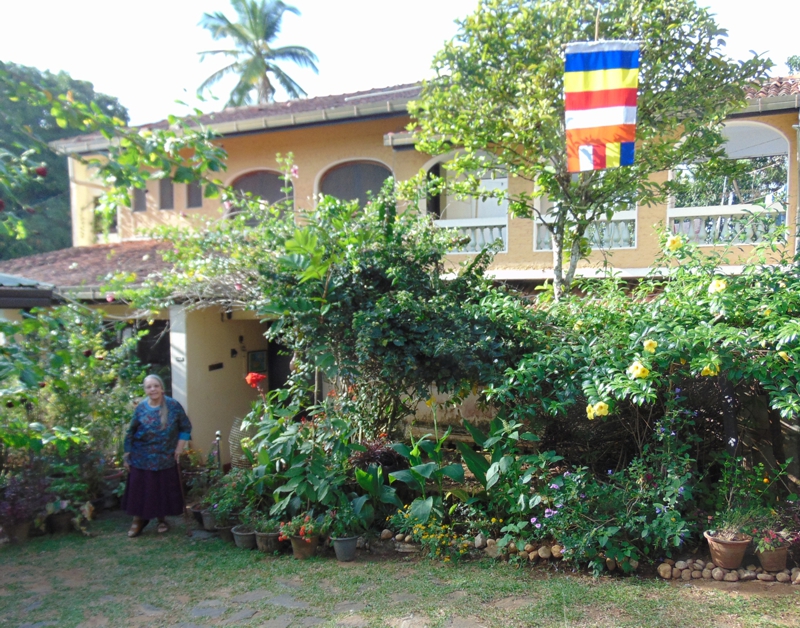 |
 |
|
|
The view from our roof terrace
|
||
 Recently, Justin, a young American professor of religion spent a few days with us. He has a Fulbright grant for a research project on Sri Lankan Buddhism. He is extremely knowledgeable and articulate about all Buddhist traditions and a wonderful houseguest, both self-catering (as Father Meaney so often said) and helpful in doing small tasks around the house. In Colombo, he met Dushy, who was pleased at how competent he was--finding her office at the university on his own and arriving right on the dot! They hit it off remarkably well: she found some connections in Colombo for his research, and he will be giving a guest lecture when he returns in May. We were happy that Justin was able to carry two copies of Jataka Tales of the Buddha for us--donations to the librairies of Wesleyan University, Ken's alma mater, and Trinity College, where Justin teaches.
Recently, Justin, a young American professor of religion spent a few days with us. He has a Fulbright grant for a research project on Sri Lankan Buddhism. He is extremely knowledgeable and articulate about all Buddhist traditions and a wonderful houseguest, both self-catering (as Father Meaney so often said) and helpful in doing small tasks around the house. In Colombo, he met Dushy, who was pleased at how competent he was--finding her office at the university on his own and arriving right on the dot! They hit it off remarkably well: she found some connections in Colombo for his research, and he will be giving a guest lecture when he returns in May. We were happy that Justin was able to carry two copies of Jataka Tales of the Buddha for us--donations to the librairies of Wesleyan University, Ken's alma mater, and Trinity College, where Justin teaches.
 A few days after Justin left, Sam arrived from India. We first met Sam when he visited us briefly in Flint, and we had not seen him since our pilgrimage several years ago. He was here for only two weeks, but it was amazing how quickly we felt that he was one of the family. Sam is a strong supporter of Buddhist prison inmates and Buddhist groups in Michigan. He knows Steve, and promised to travel to the Upper Peninsula to visit him after his return to the US. Sam is a student of Thich Nhat Hanh, the renowned Vietnamese teacher, who founded Plum Village in France. Sam belongs to a Buddhist group (sangha) in Port Huron, Michigan, where there is neither a monastery nor any monks. His group meets regularly, meditates, and studies together on their own. It was surprising to our students that there are Buddhists in that situation--without monks or nuns. We ourselves were interested to learn more about American Buddhism. Sam is a serious meditator and very articulate. Every evening, we discovered a new topic for discussion. We were sorry to see him go, but pleased when he wrote that his time in Kandy made him feel "refreshed and energized enough to face a little more time in India." Bruce calls that "Sri-hab."
A few days after Justin left, Sam arrived from India. We first met Sam when he visited us briefly in Flint, and we had not seen him since our pilgrimage several years ago. He was here for only two weeks, but it was amazing how quickly we felt that he was one of the family. Sam is a strong supporter of Buddhist prison inmates and Buddhist groups in Michigan. He knows Steve, and promised to travel to the Upper Peninsula to visit him after his return to the US. Sam is a student of Thich Nhat Hanh, the renowned Vietnamese teacher, who founded Plum Village in France. Sam belongs to a Buddhist group (sangha) in Port Huron, Michigan, where there is neither a monastery nor any monks. His group meets regularly, meditates, and studies together on their own. It was surprising to our students that there are Buddhists in that situation--without monks or nuns. We ourselves were interested to learn more about American Buddhism. Sam is a serious meditator and very articulate. Every evening, we discovered a new topic for discussion. We were sorry to see him go, but pleased when he wrote that his time in Kandy made him feel "refreshed and energized enough to face a little more time in India." Bruce calls that "Sri-hab."
 |
||
| Click the photo to see more photos of the visit. | ||
Sam's friend, Jack, has planned to come from India with him, but Jack's elderly mother's health had suddenly worsened, and he had to return to the United States. We expect that Sam will be coming back and bringing Jack to Sri Lanka within the coming year. It is something to look forward to eagerly. Actually, Jack seems to be considering the possibility of retiring in Sri Lanka, which we can heartily recommend!
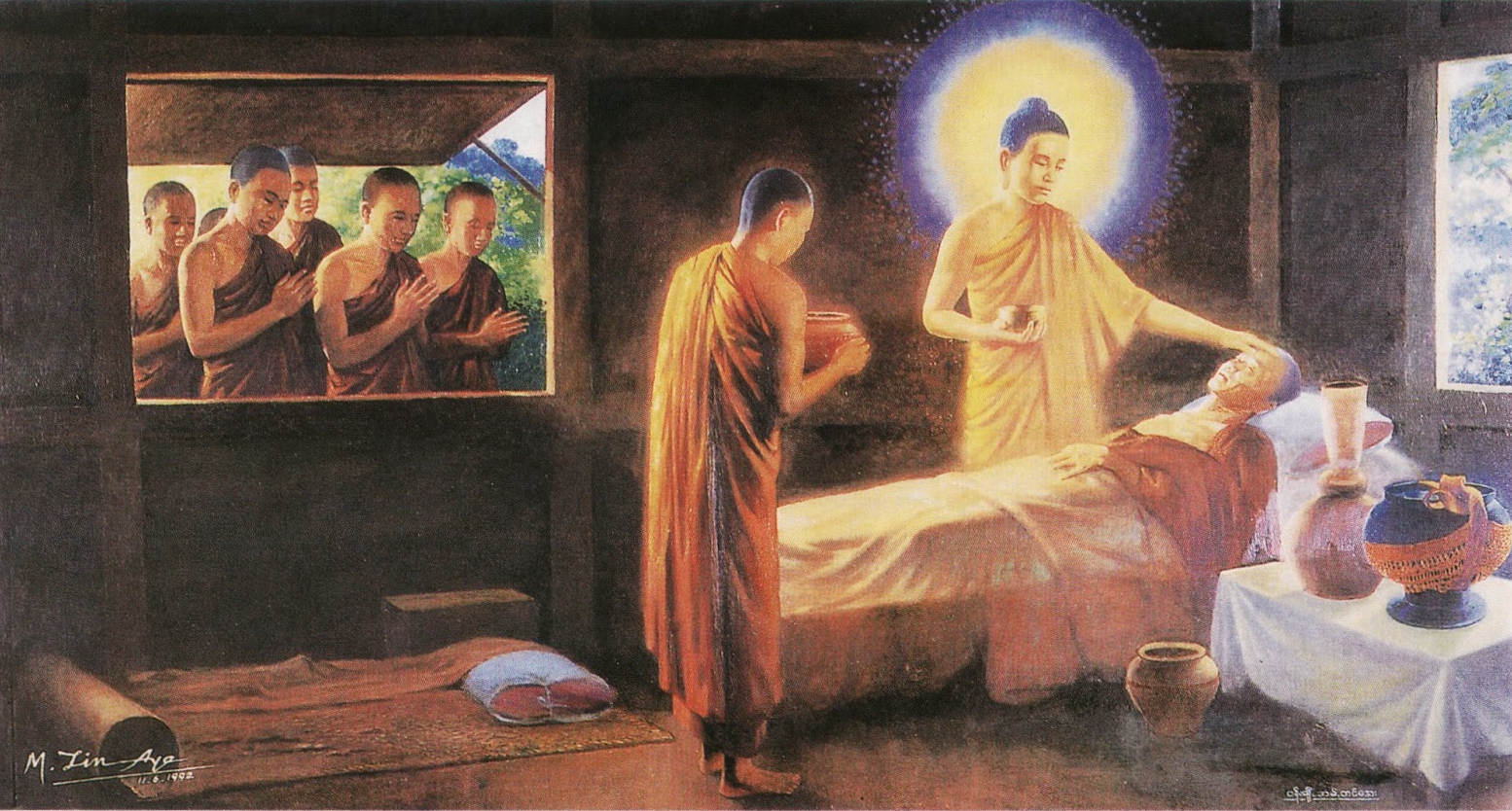 Buddhist Relief Mission has some funds earmarked for the support of ill and elderly monks. In searching for an appropriate use for these donations, we have learned that Kandy Teaching Hospital has a special Sangha Ward, which is underfunded. One particular need is for a railing for a short flight of stairs leading to the ward. We are keenly aware of the need for railings on any staircase, and we are ready to provide this.
Buddhist Relief Mission has some funds earmarked for the support of ill and elderly monks. In searching for an appropriate use for these donations, we have learned that Kandy Teaching Hospital has a special Sangha Ward, which is underfunded. One particular need is for a railing for a short flight of stairs leading to the ward. We are keenly aware of the need for railings on any staircase, and we are ready to provide this.
Also, we have been told that the Sangha ward requires sheets, pillow cases, and mosquito nets, which we will also provide. Lily's daughter, Surangi, has offered to sew the sheets and pillow cases, using locally woven cotton, and we will purchase the nets from a supplier in town. One further need is for blood pressure monitors and pulse oximeters, which we are also happy to provide.
 |
||||||
|
Donations for the Sangha Ward of Kandy Hospital are welcome.
|
||||||
|
Oximeter
|
||||||
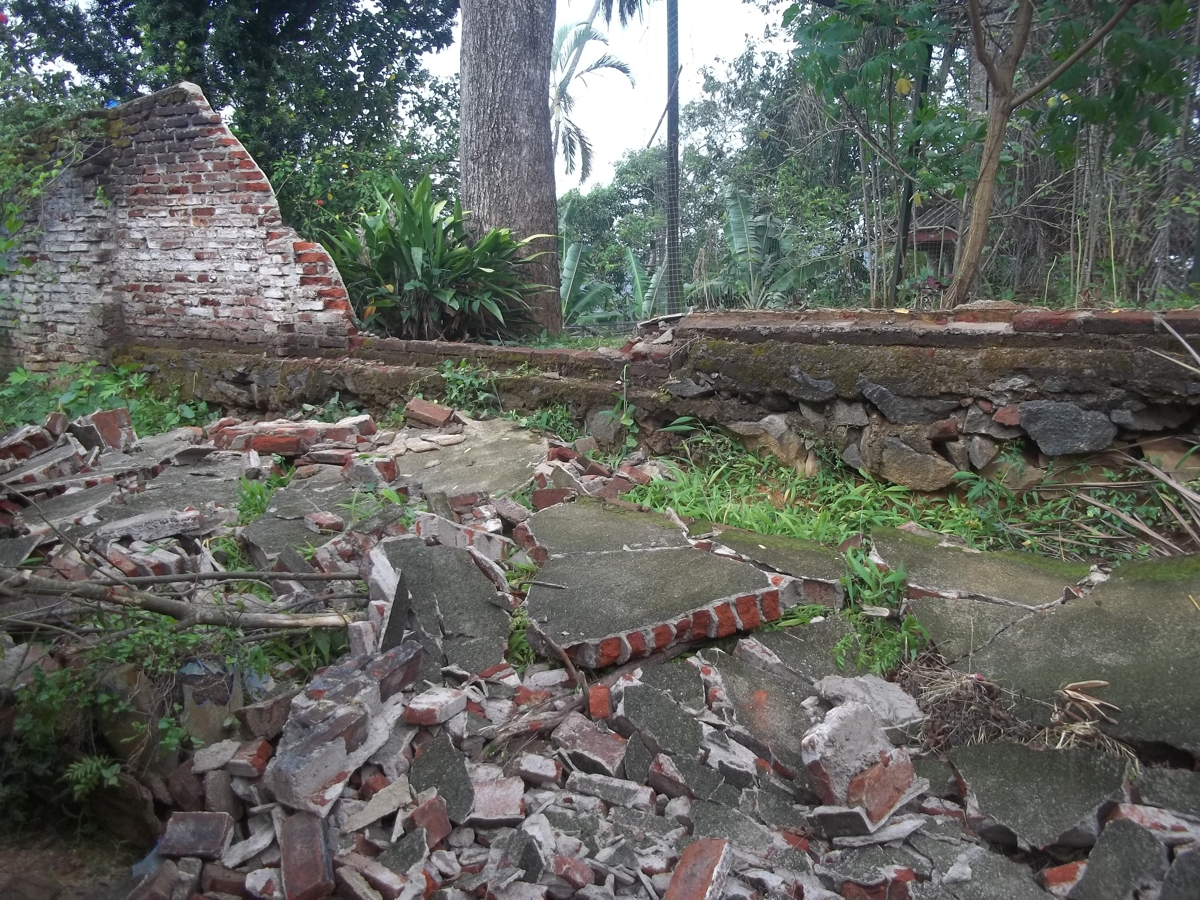 On February 11, Ashoka arrived, as he does most mornings, with our copy of The Daily Mirror and announced that Nimal had come to work on the wall. "What wall?" we asked. With a look of surprise, he asked whether we had not heard the wall fall during the night. "Which wall?" we asked again. He led us to the corner of the lot, adjacent to our first and largest "monkey cage," where we saw that about twenty feet of the brick and cement wall had fallen into the neighbor's yard. Fortunately, that area of their yard was empty, so there was no serious damage, but it was a big mess. Nimal and Ashoka spent the entire day picking up the rubble from the neighbor's yard and piling it in ours, for which the neighbors profusely thanked us. Lily immediately called the landlord and explained what had happened. It was arranged that our friend Amal, who regards our landlord as his mentor and part of the family, and his driver Mahinda would arrange for a reliable contractor to rebuild the wall. That hasn't happened yet, but we are sure that it will.
On February 11, Ashoka arrived, as he does most mornings, with our copy of The Daily Mirror and announced that Nimal had come to work on the wall. "What wall?" we asked. With a look of surprise, he asked whether we had not heard the wall fall during the night. "Which wall?" we asked again. He led us to the corner of the lot, adjacent to our first and largest "monkey cage," where we saw that about twenty feet of the brick and cement wall had fallen into the neighbor's yard. Fortunately, that area of their yard was empty, so there was no serious damage, but it was a big mess. Nimal and Ashoka spent the entire day picking up the rubble from the neighbor's yard and piling it in ours, for which the neighbors profusely thanked us. Lily immediately called the landlord and explained what had happened. It was arranged that our friend Amal, who regards our landlord as his mentor and part of the family, and his driver Mahinda would arrange for a reliable contractor to rebuild the wall. That hasn't happened yet, but we are sure that it will.
A while back, on our way to the supermarket, we were passed by a honking motorcycle, followed by a three-wheeler with someone's legs protruding -- an emergency ride to the hospital! That reminded us that, about one year ago, we had discussed with Mike the possibility of organizing a First Aid/First Responder training workshop for three-wheeler drivers in Kandy. In almost every instance, a three-wheeler driver is the first person on the scene of an accident. How good it would be, we reasoned, if many local three-wheeler drivers were trained to react professionally in aa medical emergency!
 Last month, shortly after seeing that emergency race to Kandy Hospital, we got an announcement that SLAGW-K (Sri Lanka Association of Graduate Women-Kandy), of which we are members, was presenting exactly this workshop for members (and invited guests). We immediately replied that we would attend and asked whether we could take Ashoka. The president was pleased to agree. It was a great program, and Ashoka even got to play the part of choking victim! Afterwards, he opined that every three-wheeler driver should have a chance to have the same training! Fingers crossed that a repeat can be managed with the skilled presenter at a gathering of our local three-wheeler drivers' association. It could certainly save lives!
Last month, shortly after seeing that emergency race to Kandy Hospital, we got an announcement that SLAGW-K (Sri Lanka Association of Graduate Women-Kandy), of which we are members, was presenting exactly this workshop for members (and invited guests). We immediately replied that we would attend and asked whether we could take Ashoka. The president was pleased to agree. It was a great program, and Ashoka even got to play the part of choking victim! Afterwards, he opined that every three-wheeler driver should have a chance to have the same training! Fingers crossed that a repeat can be managed with the skilled presenter at a gathering of our local three-wheeler drivers' association. It could certainly save lives!
|
Toe bone connected to the foot bone "Dem Bones", by James Weldon Johnson |
|||
At that time, he was diagnosed with cervical radiculopathy. The painkiller prescribed didn't make much difference, and he discontinued treatment. Recently, however, the sleeping fingers (about 90% of the time) were often painful, with a burning sensation, with no relief from exercise or flexing. He made an appointment with the same orthopedic surgeon who had done the earlier surgery. The nerve test results promptly came back with a diagnosis of "severe CTS." Immediately after the Mahasivarathri holiday, March 4 (Happy birthday, Dean!), Ken returned to the Channeling Center, at 4 PM, to present the results to the orthopedic surgeon and scheduled surgery for that night.
The doctor had said that he would leave the Channeling Center at 5:30, so Ken proceeded directly to the private hospital to complete the paperwork and to pay for the procedure. After registration, he was given a slip of paper and directed to the payment counter. When he finally reached the head of the line and presented his American Express card, after much hemming and hawing, he was told to go across the parking lot to the accounting office, which he did. There, his credit card was accepted, and he was given a receipt for a 7500 rupee ($42) "deposit." "Why," he asked the clerk, "is this only a deposit? When will I pay the rest?" "After the surgery," she replied. Ken pointed out that that would be quite late, and that, furthermore, since the surgery was on his right hand, it would be difficult for him to sign for the payment.
This question induced involved discussions between offices and several phone calls. He was led several times back and forth across the parking lot. Then he was told that the hospital did not know how much the doctor's fee would be, but that, if he would make a payment of 65,000 rupees ($365), he would be reimbursed for the excess. Recalling that the charge for the surgery in 2016 was only about 10,000 rupees ($66), he refused to do that. After much more discussion between offices, Ken gave up and told the clerks that he would, indeed,pay later. It was already after 6 PM, so the receptionist asked an orderly to escort him to the operating theater.
At about 7 PM, the doctor arrived, and Ken was called in. He was shown a bed and given a green gown, the standard open-in-back. He completely stripped, put it on, and was led to the operating table. The doctor explained that the right sleeve would have to be undone, and Ken lay down with the gown so loose it barely covered him. The doctor grasped his right arm, laid it on the extension of the table, and injected the anaesthetic. Ken has been through this so often--tooth, hand, finger, arm, back, foot, toe--that he didn't wince. After a few minutes, the hand was numbing, and two orderlies applied a tourniquet to his upper arm, lifted the arm and began wrapping it with rubber strapping. Just then, a nurse came to the table, presented a form, and asked Ken to sign it. Barely suppressing a laugh, he mumbled something, and pointed with his lips to his right hand being held straight up. The nurse sighed and walked away.
The surgery proceeded without a hitch, and Ken was led back to the bed, where he redonned his street clothes, with the help of an orderly who insisted that Ken keep his wrist elevated. A few minutes later, a nurse came and asked for 10,000 rupees ($56) as the doctor's fee. Ken replied that he had to pay with plastic. The nurse left, returned after a few minutes, and said, "OK." About twenty minutes later, Ken was given an invoice and a prescription and escorted out, where he found Ashoka waiting. (Visakha had called Ashoka, who located the operating theater, found Ken's shoes, and knew that he was in the right place!) The nurse accompanied them back to the accounting office, where Ken paid the final 11,500 rupees ( $65). Medicine (antibiotic and painkiller) was 1500 rupees ( $8). Ashoka picked up some rubber gloves (a bargain at 60 rupees a pair) for a shower, and they arrived home at about 9 PM.
The pain is gone, and the numbness is now restricted to only the ring finger. As soon as the doctor returns from his conference in Las Vegas, Ken will see him again to have the stitches removed and discuss the dead finger. Everything is changing!
 |
||
| Click the photo of Lal to see photos of the visit to the plantation. | ||
 |
||
| Click the photo to see more phots of the visit to the village. | ||
At the end of December, we learned that an eighteen-year-old novice staying at the temple had suddenly passed away, leaving only two monks. On February 9, we were finally able to arrange a visit to the temple where we were greeted by Manjula, his friends, the principal of the local school, other village dignitaries, and their families. We were impressed by everyone's sincerity and enthusiasm. They have formed a committee to manage the temple and to carry out the renovation. N.B. The students are doing all the work themselves!
Although we had taken food with us, expecting to offer it to the monks for lunch, both monks had been invited to a memorial dana and left shortly after we arrived. We did not have a chance even to speak with them very much. It is noteworthy, however, that it is not the monks who are making the request for monetary donations. Everything is being handled by the committee, which is as it should be. This is, in fact, the first time that we have seen such initiative on the part of young people in Sri Lanka. We had been surprised when we received the first telephone call from Manjula, but his sincerity and humble request attracted our attention. His English is good, and he expresses himself well. His first contact with us came at a busy time. We are grateful that he persisted and that we have been able to become familiar with this project. We look forward to another visit to the village and hope to be able to assist the committee and the village youth with the renovation.
Donations toward this project are most welcome.
 Plans for the Hunger Banquet continue apace. The date has been set: Saturday, May 25. It will be lunch, rather than an evening meal, as we had originally thought. As for the place, we learned that, because of Health Department regulations, prepared food from the outside is not permitted in hotels, so we had to begin looking for a suitable hall. Of course, Ashoka came to the rescue. Lighthouse Church, to which he belongs, has offered us their spacious meeting room at no charge. Also, the focus of the event has changed from the original concept. Tania suggested that we approach the Rotary Club, which we did, and the Rotary Club of Kandy readily agreed to cooperate. Through the Rotary Club, we are inviting members of the Interact Clubs of about ten schools in Kandy. Thus, the banquet has become as much an educational experience as a fund-raising, awareness-increasing event. In order to capitalize on the creativity of the students, we hope to include an art, poetry, or poster competition in Kandy's first ever Rotary-Oxfam Hunger Banquet. Lily has assured us that she, Nimal, and her team can prepare all the food, which will greatly reduce the cost and increase the amount of donation generated.
Plans for the Hunger Banquet continue apace. The date has been set: Saturday, May 25. It will be lunch, rather than an evening meal, as we had originally thought. As for the place, we learned that, because of Health Department regulations, prepared food from the outside is not permitted in hotels, so we had to begin looking for a suitable hall. Of course, Ashoka came to the rescue. Lighthouse Church, to which he belongs, has offered us their spacious meeting room at no charge. Also, the focus of the event has changed from the original concept. Tania suggested that we approach the Rotary Club, which we did, and the Rotary Club of Kandy readily agreed to cooperate. Through the Rotary Club, we are inviting members of the Interact Clubs of about ten schools in Kandy. Thus, the banquet has become as much an educational experience as a fund-raising, awareness-increasing event. In order to capitalize on the creativity of the students, we hope to include an art, poetry, or poster competition in Kandy's first ever Rotary-Oxfam Hunger Banquet. Lily has assured us that she, Nimal, and her team can prepare all the food, which will greatly reduce the cost and increase the amount of donation generated.
One of the most popular meditation centers in Sri Lanka is the Nilambe Buddhist Meditation Centre, located in the tea country high above Kandy. Many friends and visitors who have stayed with us have attended retreats at the center. We had often heard that it was a very beautiful and spiritual place, but also that, situated on a steep hillside, getting around was difficult. One other reason we'd never considered staying there is that there is no electricity, whereas Ken needs electricity at night for his CPAP machine.
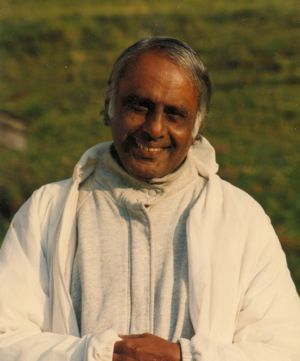 |
||
| In all the years I knew Godwin I cannot remember ever hearing him say anything negative about anyone or ever showing the slightest trace of annoyance, anger or disapproval. --Ven. Bhante S Dhammika |
||
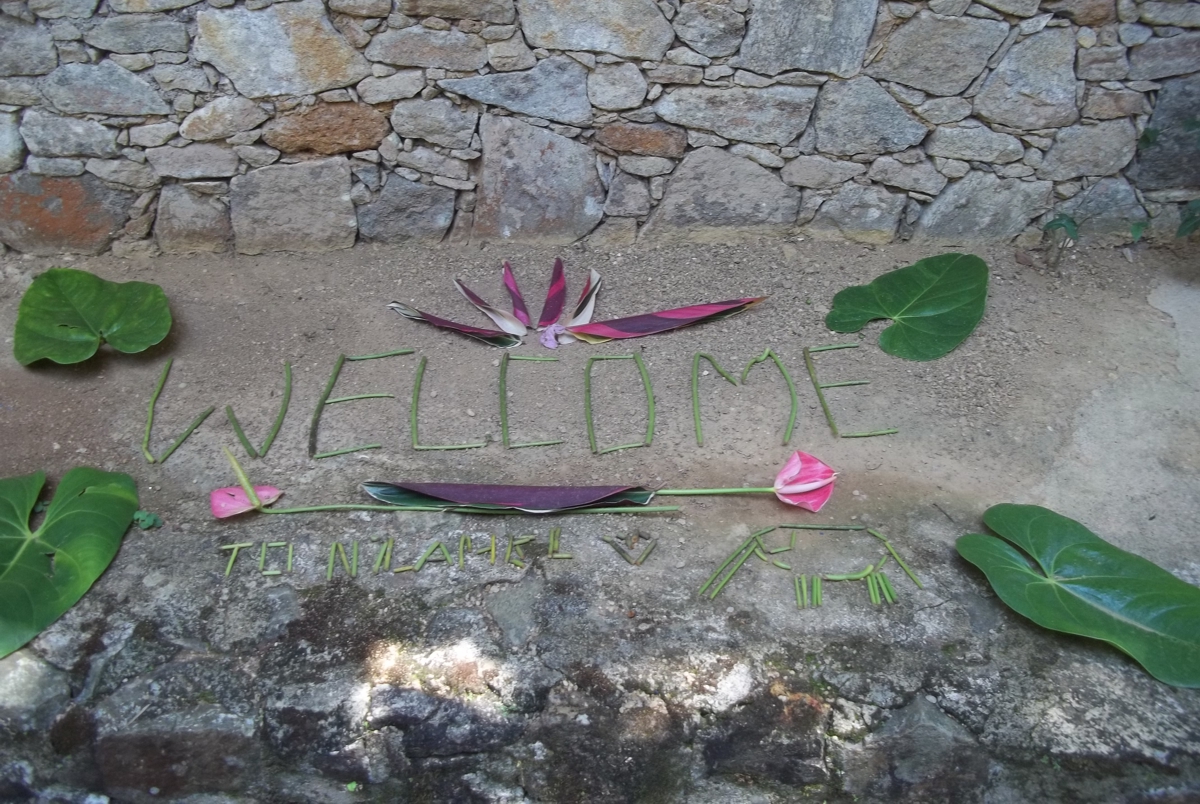 |
 |
|
It was wonderful to meet Bertie, Indira, Ven. Sathi, and many other friends whom we had not seen for some years. As we arrived, donations were being given to children from a school for the handicapped. This was followed by reminiscences of Godwin. Then, everyone proceeded to the meditation hall for a panel discussion. Unfortunately, this was up another flight of stairs, so we gave Ewen the medicine he had asked us for and bade farewell. Before we left, we selected several booklets and a CD of Godwin's teaching, which we will share with friends.
|
Forgiveness First of all, I want to talk about some popular misconceptions about forgiveness. Forgiveness doesn’t imply that we are weak, that we can’t stand up to those who cause suffering to others. It doesn’t condone behavior that causes suffering, and it doesn’t stop us from acting to prevent a recurrence of or to mitigate the effects of unskillful action. Indeed, right action is always easier if it is not done from a place of pain. Otherwise, we might find that the action we take just causes more suffering for ourselves and others. |
|||
We returned by the rocky road, but then Ashoka took a left turn, and we found ourselves on a different road, which had been recently carpeted. We strongly suspected that Ashoka had never been there before. For a few miles, until we regained the road to Mahakanda, we think that Ashoka was lost, but he would never admit it. It was fun, and we ended up exactly where we wanted to be, with no loss of time!
 Ever since we published A Pilgrim's Companion: Readings from Buddhist Texts to Enhance a Pilgrimage to the Sacred Sites, we have been trying in vain to have the book available in BuddhaGaya for the thousands of pilgrims who begin their pilgrimage there. It was reprinted in Kolkata, but distribution of that edition was limited almost exclusively to Burmese pilgrims. At last MahaBodhi Book Agency has agreed to publish a new edition for general distribution in India. Within a few months, we hope to see it in many bookstores, including those at all the pilgrimage sites. Hooray! Thank you, Jayadewa, Mr. Jayawardana, and Ven. NandoBatha, for arranging this. We are so glad the book will be available and enjoyed!
Ever since we published A Pilgrim's Companion: Readings from Buddhist Texts to Enhance a Pilgrimage to the Sacred Sites, we have been trying in vain to have the book available in BuddhaGaya for the thousands of pilgrims who begin their pilgrimage there. It was reprinted in Kolkata, but distribution of that edition was limited almost exclusively to Burmese pilgrims. At last MahaBodhi Book Agency has agreed to publish a new edition for general distribution in India. Within a few months, we hope to see it in many bookstores, including those at all the pilgrimage sites. Hooray! Thank you, Jayadewa, Mr. Jayawardana, and Ven. NandoBatha, for arranging this. We are so glad the book will be available and enjoyed!
| Caseyriverpoint Amazon Seller Account | ||||||||
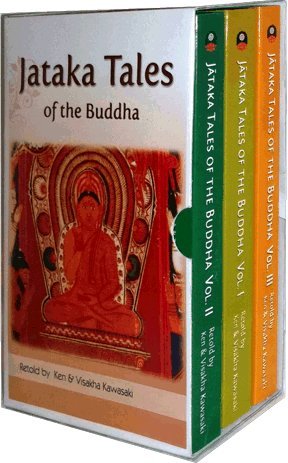 |
 |
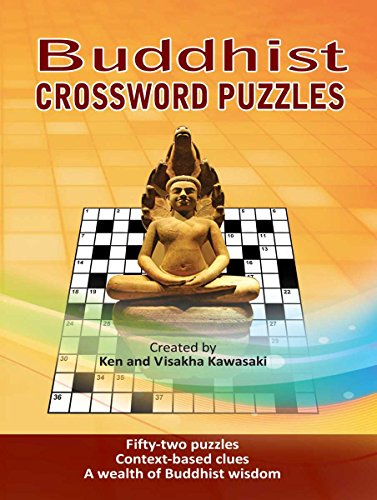 |
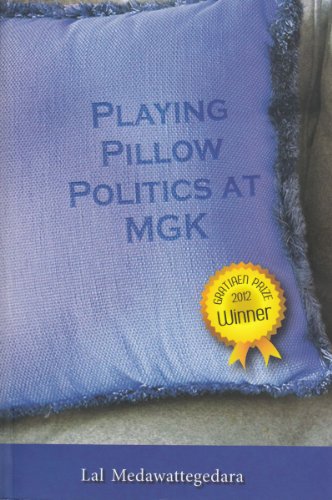 |
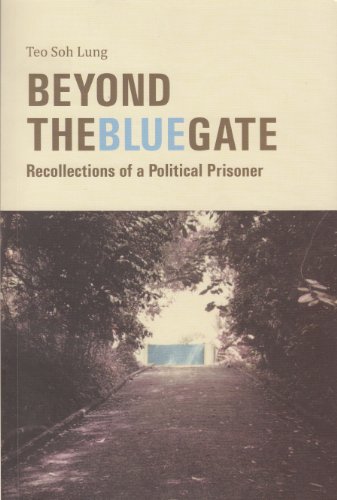 |
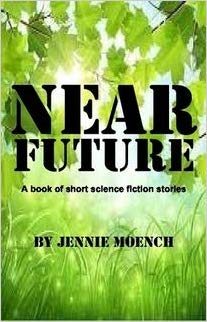 |
|||
In previous reports, in order to highlight an article for our readers, we often inserted an image, usually a photo, from the article, using it as a link to the article itself. We were never claiming that those photos were ours, nor were we using them for any profit. We saw them merely as convenient and attractive links to interesting websites. Imagine our astonishment when we received, a few months ago, a letter from an agency representing AFP, informing us that we had misused two copyrighted photographs several years ago and informing us that we were being charged a fee of $1300. We immediately contacted the agency to discuss the matter. We explained our position and apologized for the unintentional mistake. The representative we spoke with insisted that the case could not be dismissed, insinuating that court action was the only alternative, but he informed us that, as a non-profit organization we would be granted a 55% reduction to $595. We have heard that some publications regularly "steal" photos from the wire services, or freelancers, and that our case might have been an instance of "harassing the little fellow" (or, perhaps, some suggested, even a scam), but we are not in a position to risk going to court, no matter where it might be, so we paid the fee, removed the photos, and, beyond that, removed all such images from previous reports. Let us hope that the matter will never come up again! We believe in intellectual property, but we also think there should be "fair use." Isn't it ironic that Buddhist Relief Mission, a small non-profit, was penalized for using a powerful photo of Rohingya refugees to protest their genocide?
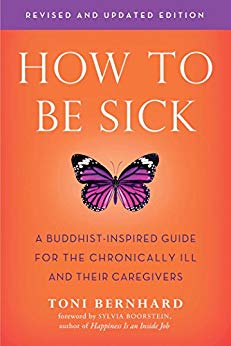 Regarding "intellectual rights," here is an interesting anecdote. Ewen has recommended a book, How to Be Sick: A Buddhist-Inspired Guide for the Chronically Ill and Their Caregivers, by Toni Bernhard. We highly recommend it to you, as well. The author includes many useful and effective exercises for dealing with anger, depression, and other unwholesome emotions. She encourages her readers to practice these exercises in their daily lives. Ewen, conscientious, honest, and scrupulous, contacted the publisher and asked whether he could legitimately include these exercises in his meditation teaching at Nilambe. Permission was refused!
Regarding "intellectual rights," here is an interesting anecdote. Ewen has recommended a book, How to Be Sick: A Buddhist-Inspired Guide for the Chronically Ill and Their Caregivers, by Toni Bernhard. We highly recommend it to you, as well. The author includes many useful and effective exercises for dealing with anger, depression, and other unwholesome emotions. She encourages her readers to practice these exercises in their daily lives. Ewen, conscientious, honest, and scrupulous, contacted the publisher and asked whether he could legitimately include these exercises in his meditation teaching at Nilambe. Permission was refused!
The Sunday Times publishes, as part of "Hit Ad," their section of classified ads, a small magazine, "Travel." Each issue usually contains an assortment of unrelated articles highlighting various tourist attractions around the world, with at least one describing something in Sri Lanka. On March 17, the magazine carried the subheading, "Green Edition." Every article, placed, of course, between the ads for package tours, dealt with environment protection, mostly related to tourism. This was the first time for us to see anything of this sort in Sri Lanka. We immediately scrolled through The Sunday Times website, hoping to find the link to the magazine to share it with you. It was not there. We realized that the articles were selected from various news agencies and websites. Using the titles, we were able to find all but two of them. We must praise the editors who did the research for this magazine. It is an impressive and informative collection. Actually, it reminded us of our "Plastic News," but, here, the articles are complete, and the photographs and layout are very attractive. We are happy to share it.
On Sunday, February 10, Surangi and her in-laws opened a sweet shop in Kandy.We were honored to be invited to the dedication and to be the first customers.
 |
 |
 |
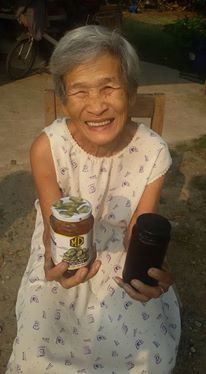 |
||||||||||||||||||||||||||||||||||
|
Joanne and Janet from the United States
|
Shirley and Mark from Australia
|
Lily's new shiatsu foot massager
|
Eid's mother with mango chutney from Sri Lanka
|
||||||||||||||||||||||||||||||||||
|
SERVAS day guests
|
Happy feet!
|
||||||||||||||||||||||||||||||||||||
 |
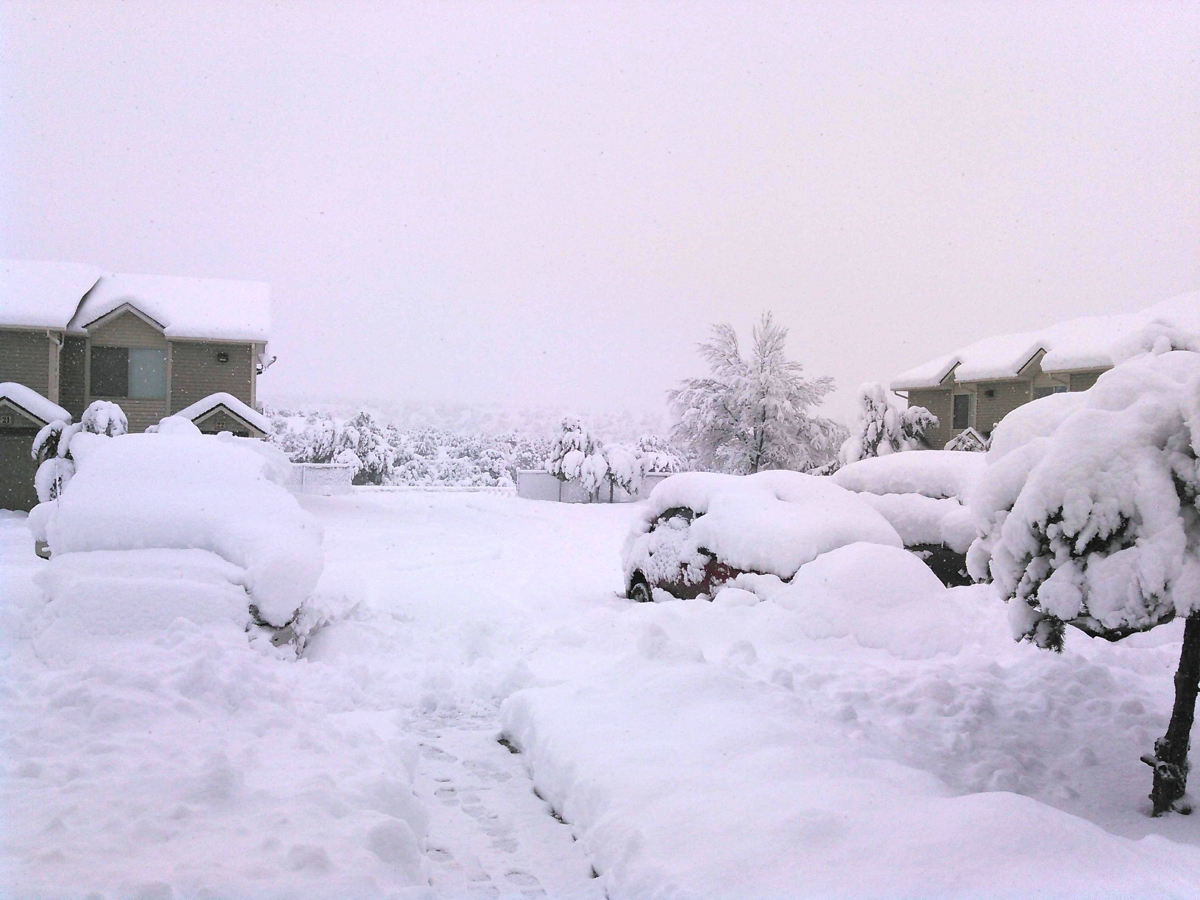 |
 |
|||||||||||||||||||||||||||||||||||
|
Our friend, Pedro, sent photos of Cibacue,AZ, to remind us what snow looks like!
|
Class resumed after a long hiatus
|
||||||||||||||||||||||||||||||||||||
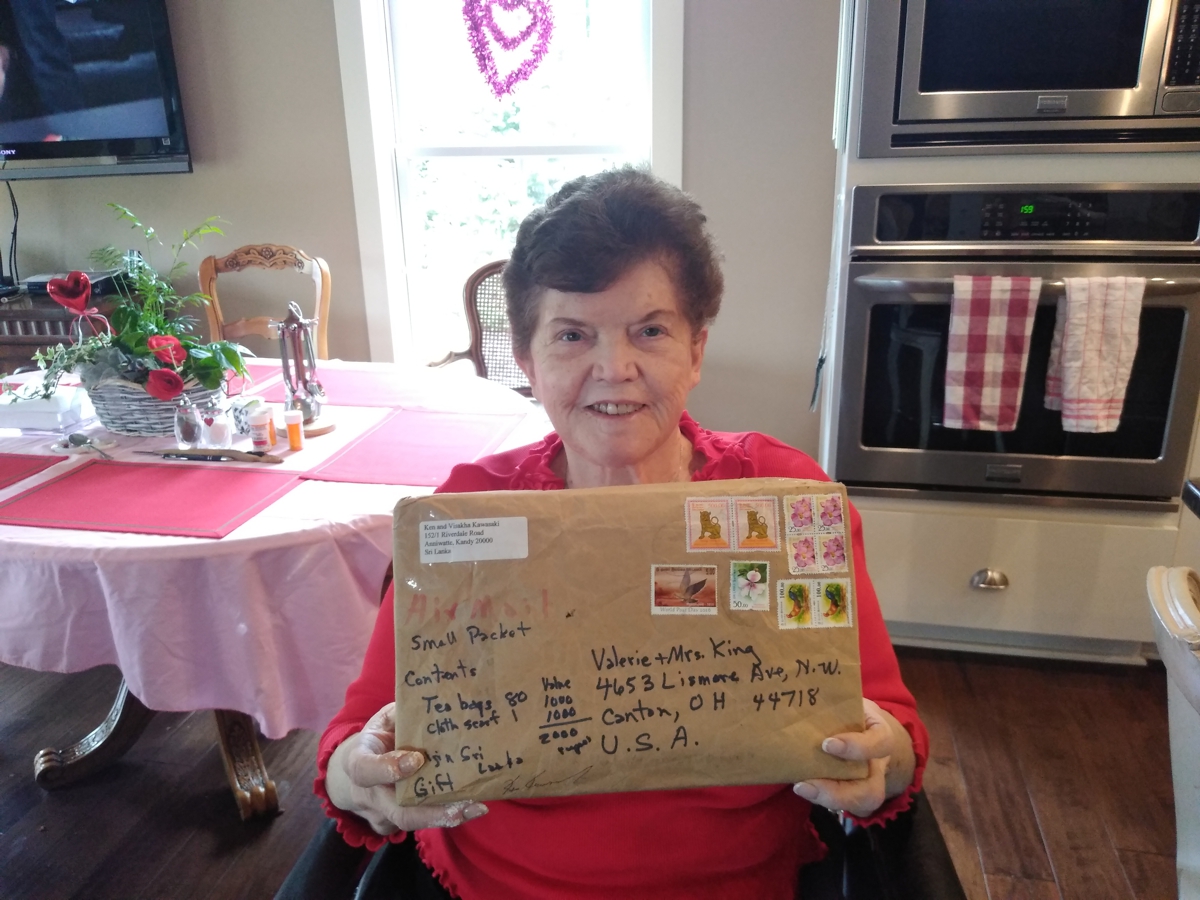 |
 |
A beautiful book by Jayanthi Edirisinghe,
President of Sri Lanka Association of Graduate Women-Kandy, et al Originally a rubber plantation, Mahausakande rainforest grew out of the conservation efforts of Mrs Nalini Ellawala of the Ellawala Foundation. Many years later, visiting the forest, armed with a camera, was Mr Roman Prokhorov, who showed his photographs of insects of Mahausakande to Mrs Ellawala. Motivated by a desire to share these stunning photographs with the public, and a concurrent wish to showcase what conservation has achieved in Mahausakande, Mrs Ellawala sought the assistance of the authors who are entomologists, to complement these photographs with understandable text. |
|||||||||||||||||||||||||||||||||||
|
Valerie's mother receiving our gift on Valentine's Day
|
|||||||||||||||||||||||||||||||||||||
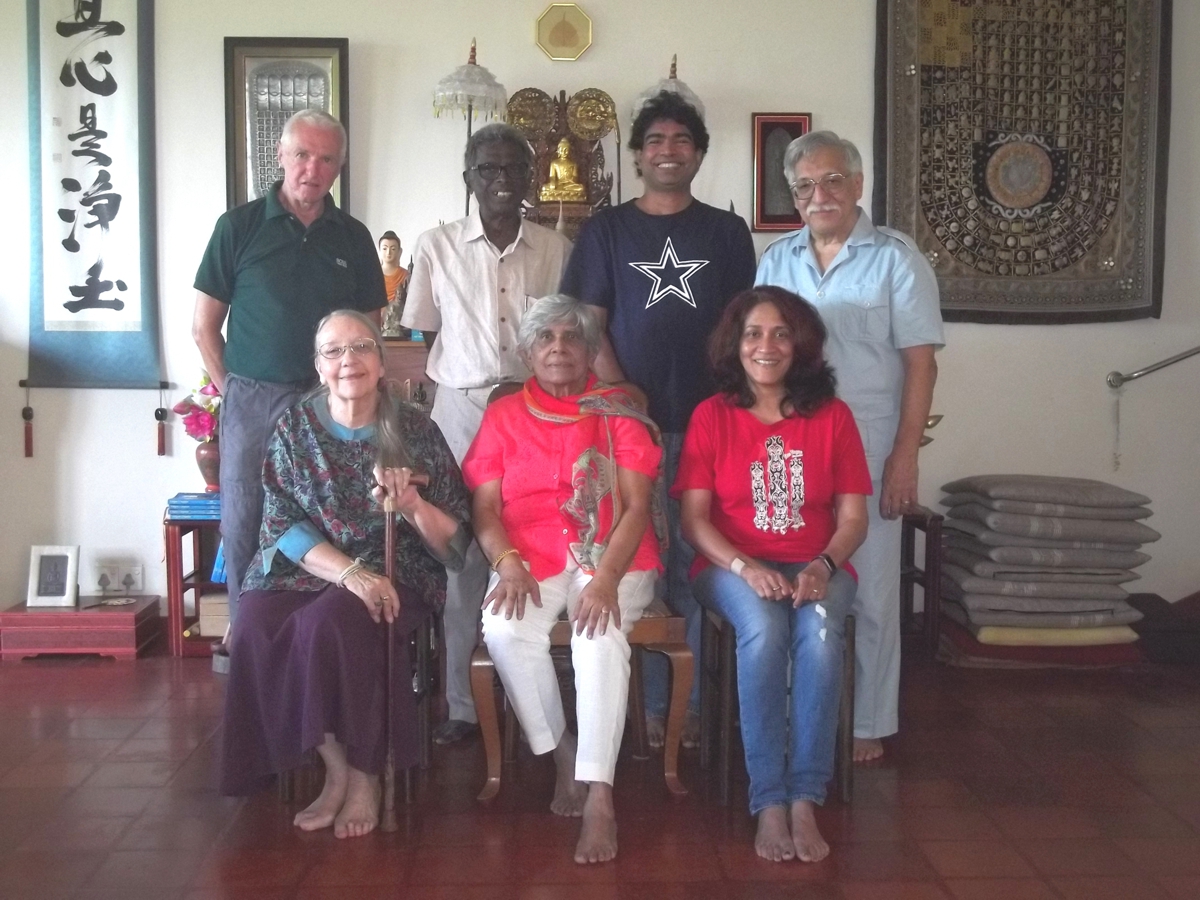 |
 |
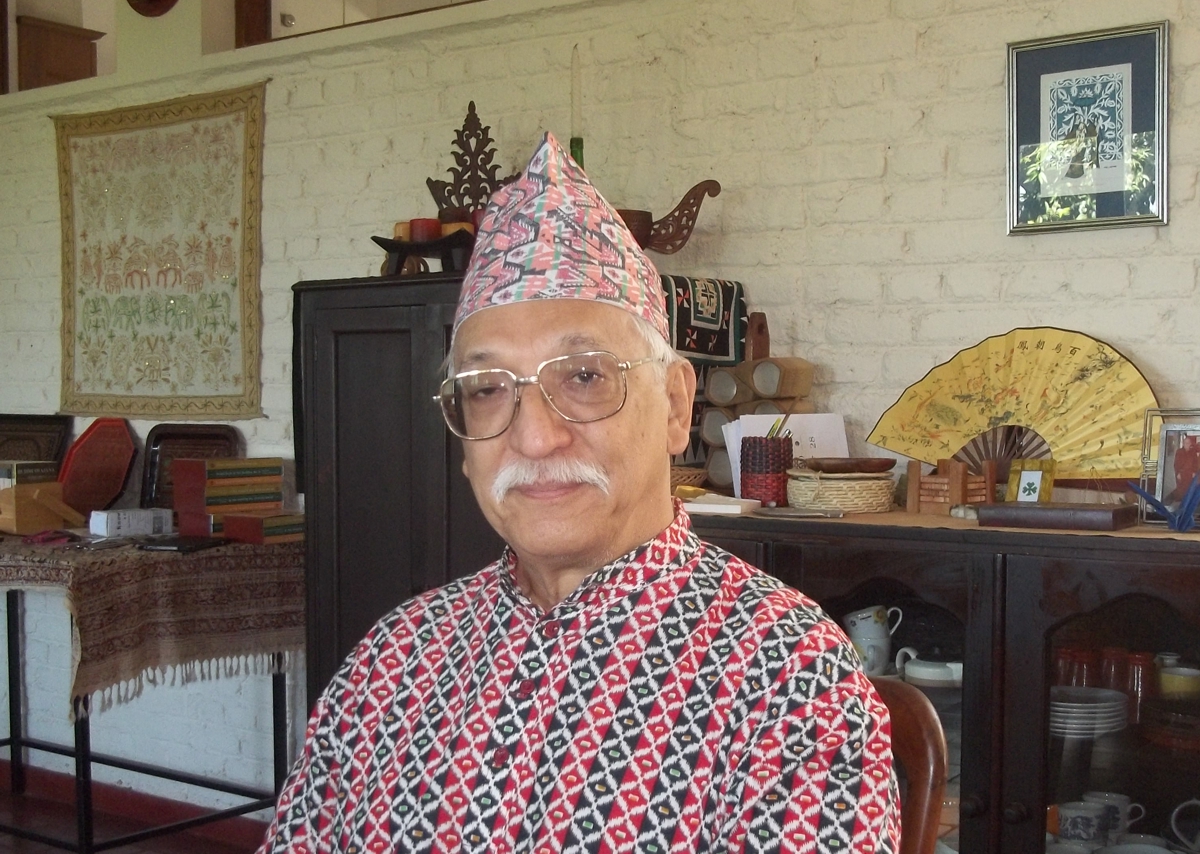 |
|||||||||||||||||||||||||||||||||||
|
Ewen, Jaya, Lal, Ken
Visaka, Lalitha,Vivi |
Sam and Vens. Nandasila, Janaka, Lekdron, and Wangmo
|
||||||||||||||||||||||||||||||||||||
|
Ken, Nepalese style
|
|||||||||||||||||||||||||||||||||||||
 |
 |
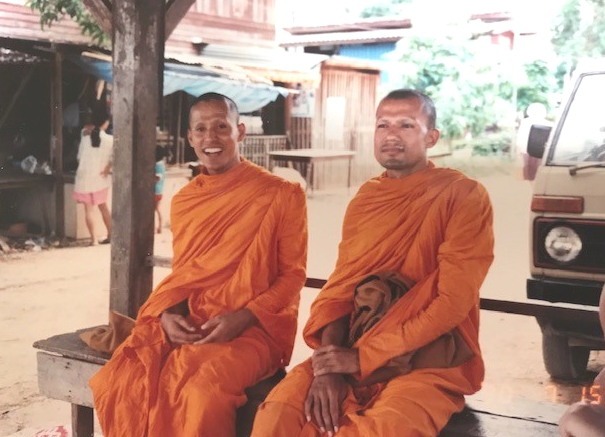 |
 |
||||||||||||||||||||||||||||||||||
|
Memories of Vens. Assajita and Dhammagupta from Terry
|
|||||||||||||||||||||||||||||||||||||
 |
A fascinating history, with intriguing relevance to the current world situation .
Click the cover for the Amazon site. Click below to read a review in The New York Times. How Christians Destroyed the Ancient World By Bettany Hughes |
||||||||||||||||||||||||||||||||||||